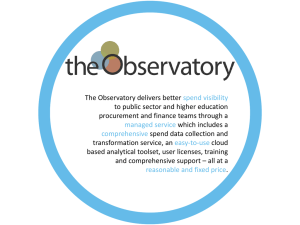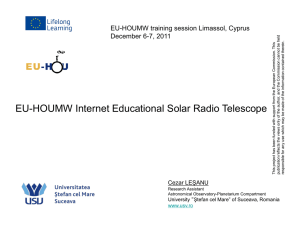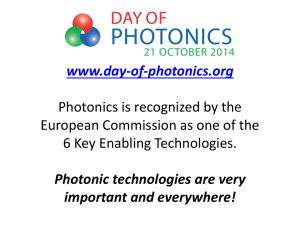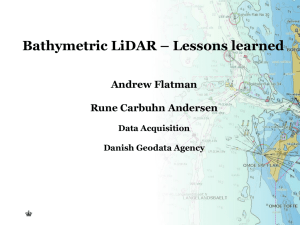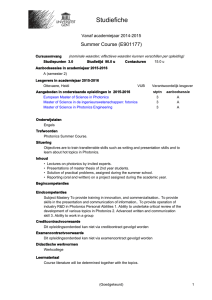2013 May 31 Presentation on AO Lidar and PRPI
advertisement
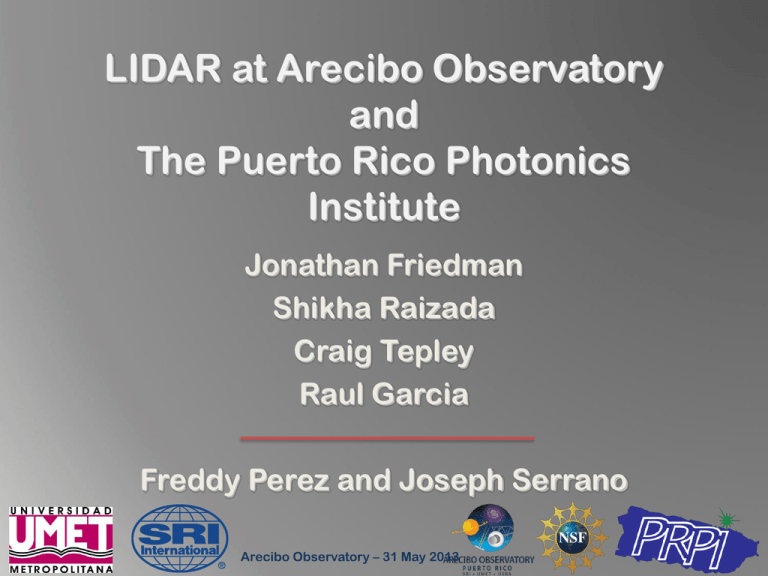
LIDAR at Arecibo Observatory and The Puerto Rico Photonics Institute Jonathan Friedman Shikha Raizada Craig Tepley Raul Garcia Freddy Perez and Joseph Serrano Arecibo Observatory – 31 May 2013 What is LIDAR? Arecibo Observatory – 31 May 2013 Why Different Colors? Arecibo Observatory – 31 May 2013 Arecibo Observatory – 31 May 2013 1 0 10 100 1000 10000 500 100 200 Altitude (km) 1000 Channel # Rayleigh Scatter Resonance Scatter Sporadic Layer Meteor Region Photon counts PMT Gain Switching 1500 Atmospheric Structure and LIDAR What is the added value of lidar for Arecibo Observatory? • The ISR is sensitive to ions • The lidar is sensitive to neutral atoms and molecules, and one specific ion can be studied – Ca+ • Airglow can study specific height ranges, lidar can probe inside and outside those ranges. • Under certain circumstances, lidar and radar, lidar and airglow, or all three can study the same parameters. This allows confirmation (or not) of measurements. Arecibo Observatory – 31 May 2013 What do we study with lidar? • • • • • Atmospheric Dynamics Atmospheric Chemistry Global Change Sun-Earth Interactions Also … – Sahara dust – Cirrus clouds – Water vapor Arecibo Observatory – 31 May 2013 Tepley et al., 2003 K LIDAR Electrons Radar Ca+ LIDAR Simultaneous Lidar and Radar Observations from 2002 11-12 June 2002 12-13 June 2002 14-15 June 2002 Temperatures, Neutral, and Ions Delgado et al., 2012 The Puerto Rico Photonics Institute • The only center for photonics research, development, education and training in Puerto Rico. • A magnet for industry • A partner for research and education Arecibo Observatory – 31 May 2013 What is Photonics • Photonics is the manipulation of light for technology development, science, and other applications. • It is used in Communications, navigation, displays, remote sensing, biotech, medical devices, defense, security, energy, astronomy, space weather, computing, lighting, materials processing, environment, transportation, entertainment, computeraided design… Arecibo Observatory – 31 May 2013 What tools does Photonics Employ? • Lasers of all types (from DVD players to welding) • Fiber optics • Sensors, such as CCDs (a gift from astronomy) • Electronics, to connect optical signals to devices • Optical components (lenses, mirrors, etc.) Arecibo Observatory – 31 May 2013 Photonics as a Career • Fast-growing technologies ⇒ Workforce needs • Fascinating work ⇒ Lasers, sensors, metamaterials, holograms, fibers, spectrum generation … • High salaries ⇒ Orlando, FL photonics companies pay >$40k/year for technicians with AAS degrees & little experience Arecibo Observatory – 31 May 2013 What is the Puerto Rico Photonics Institute (PRPI)? • The only center for photonics research, development, education and training in Puerto Rico. • A magnet for industry • A partner for research and education • Links: http://prpi.suagm.edu • http://www.facebook.com/PRPhotonics • Twitter: @PRPhotonics Arecibo Observatory – 31 May 2013 Education and Training Certificates Associate Degrees Master’s Degrees Lasers, Fibers, Laser Gyros, Spectroscopy, Optical Design, Remote Sensing • All courses will be taught in English • All degrees and certificates will require research participation • • • • Arecibo Observatory – 31 May 2013 Research • Current – Remote Sensing ⇒ LIDAR at Arecibo, elsewhere – Aerospace Photonics ⇒ Laser gyroscopes for navigation and sensors • Future – Space Weather ⇒ Monitoring stations, prediction center – High power lasers – Biophotonics ⇒ A hot field. We will look to add this to our research portfolio. –… Arecibo Observatory – 31 May 2013 PRPI is supported by grants from … • SUAGM $1.5M • The Puerto Rico Science, Research, and Technology Trust $210K • The Puerto Rico Industrial Development Company $273K • MIT Draper Laboratory $65K ($130K) • The National Science Foundation $660K Arecibo Observatory – 31 May 2013 Photo: J. Friedman, Arecibo Photo ©Tachi Laboratory, U. Tokyo http://prpi.suagm.edu http://www.facebook.com/PRPhotonics Photo: Chris Gunn Arecibo Observatory – 31 May 2013 Twitter: @PRPhotonics
